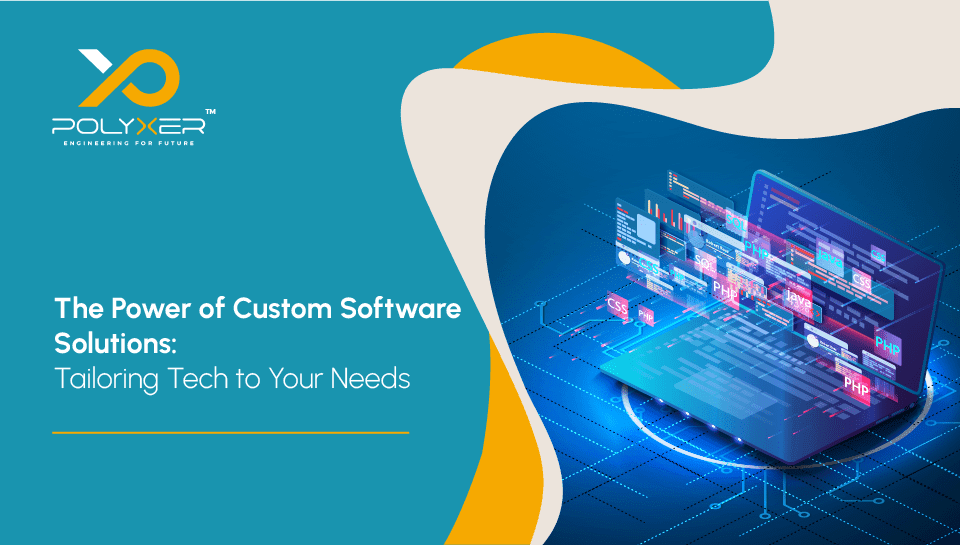
Feature-Driven Development: A Success Software Development Delivery

The Power of Custom Software Solutions: Tailoring Tech to Your Needs
Introduction
Adopting the wrong technology stack or continuing to use the same is a huge mistake that can cost you a lot of money in the long run. For instance, if your software application doesn’t have the right tools, then there can be a high risk of a performance gap.
A technology stack is basically a set of tools and technologies used to design and develop mobile applications, web applications, or software applications. The significance of using the right technology stack for your project can’t be underestimated.
But as soon as you start your research, you discover there are so many choices available. How will you know which is the right technology stack for a software development project?
Like every tricky question, the answer to this question is – it depends.
It depends on project type, size, requirements, and more such factors. In this blog post, we’ll give you an overview of technology stacks, how to select the right one for your project and things to consider to help you make an informed decision about your future tech stack.
What is a Technology Stack?
A technology stack is the collection of tools, apps, platforms, frameworks, programming languages, libraries, and third-party integrations that a developer uses to create a software product.
In simple terms, it's an aggregation of tools and technologies for creating websites and applications that can carry out seamless business operations and enhance performance metrics.
Applications have two software components: Front-end and Back-end. Both these layers of applications are developed using a technology stack.

Front-End:
Effective tools and technologies are used to enhance user interactions and provide an accessible and enjoyable user experience.
Back-End:
Functional tech stacks are used to ensure all features are promptly responding to user requests.
Popular Technology Stack For Web & Mobile Applications
There are a number of front-end and back-end technologies for both web and mobile applications. Different projects require different types of tech stacks.
Some functional tools might be beneficial for web applications but might not be needed for mobile applications. Let’s take a look at popular tools and technologies that can be used for web and mobile application development.
1. Web Development Technologies
Tech stacks used for creating web applications are categorized into frontend and backend technologies.
➤ Back-end Technologies
The server-side technologies ensure the back end operates smoothly. Developers can use the following back-end technologies for building functional websites.
Programming Languages:
Java, Python, GO, C#Objective-C, PHP, Dart, etc are common back-end programming languages used to develop features and functionalities.
Frameworks:
It is used to create scalable and more customizable web applications. Some of the popular back-end frameworks are Django, Laravel, Node.Js, Ruby on Rails, React Native, Express JS, Xamarin, Flask, Swift, and Objective-C.
Operating System:
This is where web servers, frameworks, programming languages, and other elements exist and obtain requisite resources. The best operating systems for the backend are macOS, Linux, Android, Windows, and iOS.
Databases:
A database is used to store, collect, process, and manage information accumulated from different sources. Some of the common database languages like MongoDB, PostgreSQL, Graph SQL, and MySQL can be used for their powerful features and tools.
Server Providers:
Web servers such as Apache, IIS, and Nginx can be useful to store, process, distribute, and maintain complex and static information in the backend.
➤ Frontend Technologies
The client-side technologies are used to develop interactive features and functionalities for web applications. Below are some efficient front-end technologies that can be used for creating web applications with high user engagement.
HTML:
HTML (Hypertext Markup Language) is the backbone of the website application. It helps in structuring and organizing the website content.
CSS:
CSS (Cascading Style Sheet) complements HTML by providing features to beautify the content. It offers attractive colors, fonts, background elements, layouts, etc. to represent the data attractively.
JavaScript:
To boost user interaction, JavaScript is the best option. It is a programming language used to make websites more interactive and dynamic.
2. Mobile Application Technologies
➤ Tech Stacks For iOS Applications
Below are the common iOS tech stacks used to create a product for Apple devices:
- Programming Languages: Objective-C and Swift
- Development Tools: Xcode and AppCode
- UI Frameworks: UIKit and SwiftUI
➤ Tech Stacks For Android Applications
Following is the list of popular tech stacks for mobile application development:
- Programming Languages: Java and Kotlin
- Development Tools: Android Studio and Android SDK
- UI Frameworks: Jetpack Compose, Android UI, and UI kit
Now that you know the different types of technology stacks for web and mobile applications, let us help you to pick the right technology stack.
How to Choose The Right Tech Stack For Your Software Development Project?
Step 1: Define The Product
The first step is to identify whether you need a product with minimum features or a high level of features and performance.
If you need to create an MVP, go for scalable tech frameworks that help you create core features to gather timely feedback with high responsiveness.
On the contrary, if you need to develop a feature-rich product, use tools and technologies that help you build attractive user interfaces for optimum user experience.
Step 2: Determine The Project Scope
The project scope involves identifying deadlines, tasks, roles, responsibilities, and expected deliverables.
Determining your project scope will help you figure out your business requirement and what software functionalities and architecture you need for your project.
As a result, it will help you choose the right technology stack that suits your specific project and business requirements.
Step 3: Choosing Technical Stack
Now it’s time to select the right tech stack. Before you choose any tech stack for your project, it's important to consider the following things to make the right decision.
- Your business and project goals
- Skill-set of team member
- The problem that needs to be solved
For instance, if you want to build a product for internal use, ensure that it is compatible with existing software. To come to the point, use tech stacks that fit your goals.
Lastly, we know choosing tech stacks that align with your business goals is a complex process, especially when you come from a non-technical background. To make it simpler, it is important to consult with the highly skilled and experienced development team of a software development company to make sure you choose the right technology stack.
Things To Consider When Choosing A Technology Stack
Key factors to consider before opting for a technology stack for your project:
1. Scalability:
If you have future plans to scale your application, then don’t forget to use a technology stack with the potential to scale effectively. Using a scalable technology stack from the start can save a lot of time and cost of making modifications later.
There are two types of scalability – vertical and horizontal.
- Vertical scalability refers to adding more features and functionalities without affecting the effectiveness of codebases.
- Horizontal scalability means the capability of the application to operate on different devices.
2. Performance:
If performance is your goal, then you must choose the tech stack that helps you create an application with the ability to operate fast and react to multiple requests quickly.
3. Budget:
Software development requires a significant financial amount to get the job done. Hence, it’s important to consider various points such as developers’ salaries, hosting costs, license fees, and maintenance costs in mind and balance things out. You must avoid overspending on technology stack wherever possible.
4. Personal Requirements
It’s necessary to consider the technology based on your business goals and the problem you want to resolve. Selecting the wrong technology might result in poor user experience and technical debt. Therefore, first, identify your goal and objective and then the technology required to meet the requirements.
5. Security
Whether it’s a web application or mobile application, they need to handle sensitive information that needs to be secure appropriately. For building a secure architecture, use technologies with security and threat mitigation in mind.
6. Project Size
Small-size projects generally don’t require advanced tech stacks and can be easily developed using simple tools and open-source platforms.
On the other hand, mid-size or large-size projects require a high level of technological involvement to deliver advanced functionalities and performance.
Popular Technology Stacks For Businesses
➤ Tech Stacks For Web Applications
1. LAMP
Suitable for top-notch performances and functionalities in web applications.
Stack Components:
- Linux (Operating System)
- Apache (Server)
- MySQL (Database)
- PHP/ Python / Perl (programming language)
Benefits:
- Open Source
- Allows component replacement as per technical requirement
- Easy to set up
2. MEAN
Suitable for creating dynamic websites and web applications.
Stack Components:
- MongoDB (Database)
- Express.JS (For backend framework)
- Angular.JS (frontend framework)
- Node.JS (JavaScript runtime environment)
Benefits:
- Cost-Effective
- Easy to add elements and make new changes
- Quick and easy project deployment on the server
- A single JavaScript developer is enough to do the job
3. MERN
Stack Components:
- MongoDB (Database)
- Express.JS (Server-side website framework)
- React (Frontend framework)
- Node.JS (Javascript runtime environment)
Benefits:
- Advanced UI elements of React
- Economically beneficial
- Large community support
- Support quick scalability
- Easy to find MERN developers
➤ Tech Stacks For Mobile Applications
1. Native Tech Stacks
Ideal for creating mobile applications that can work seamlessly on each operating system.
Advantages:
- Broader functionality
- Fast and responsive performance
- Optimum user experience
- Highly secure
2. Cross-Platform Tech Stacks
Ideal for building a single mobile application compatible with multiple devices.
Advantages:
- Faster development
- Reduced costs
- Reaches more audience
- Standard UI/UX
Grow Your Business With Right Tech Stack
With so many technology stacks available these days, there is no need to use complex, ineffective, and time-consuming tools and software. Developing your software project using the best tech stack ensures positive and lasting results for your business.
After reading this blog, we hope you have a firm understanding of choosing a reliable technology stack. However, if your product development needs a skilled hand, Polyxer Systems is here to help you out.
At Polyxer Systems, we have a team of skilled developers with years of experience and expertise in various development technologies. Reach out to us, and we will help you get the best technology stack for your project for successful software development.
Learn more about our software development services here.







